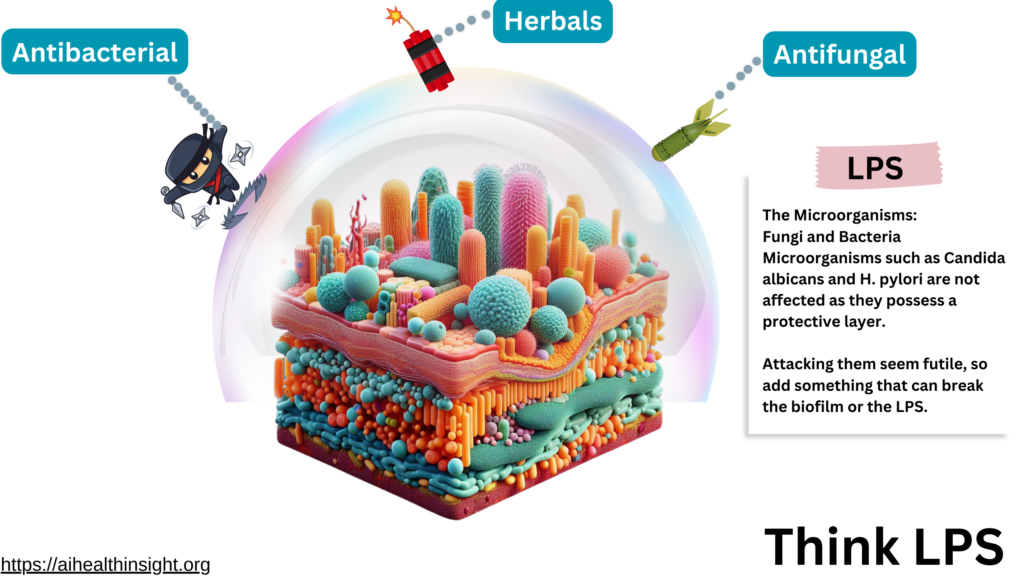#H. Pylori #candida Albicans #Bioflim # LPS
This is the third article but you need not read the first two part to get the point. This is all inclusive.
What is LPS, Bioflim and or Extracellular Matrix (EMC)?
LPS, BioFlim or Extracellular Matrix (ECM) are word to describe the combination of the following molecurles by various bacteria, fungal and other patogens in the body. They are all the same creation all be it some stronger than the other hance we try to use different word.

The Bubble protecting the bacteria, fungus or whatever microbe that spurne it into being.
LPS (Lipopolysaccharide): ( house of staw – level 1) easier to break but it take strategy – think NAC, Cintosan, Zeolite clay and many other substance that can bind and break the LPS to allow the anitfungal and anitbiotics to get to those pesky bacteria, fungus or microbes.

Lipopolysaccharides (LPS) are large molecules found in the outer membrane of Gram-negative bacteria. They play a crucial role in the structural integrity of the bacteria and can act as endotoxins, eliciting strong immune responses in humans and other animals. LPS is composed of three main parts:
- Lipid A: This is the toxic component of LPS and anchors the molecule to the bacterial membrane.
- Core Oligosaccharide: A short chain of sugars attached to Lipid A.
- O-antigen: A variable polysaccharide chain that extends outward from the bacteria, contributing to its antigenic variability.
Biofilm: – House of sticks, it take more effort and better strategy.

A biofilm is a structured community of microbial cells enclosed in a self-produced polymeric matrix that adheres to surfaces. Biofilms are formed by bacteria, fungi, and other microorganisms and are characterized by their resistance to antimicrobial agents and the host immune system. The biofilm matrix is primarily composed of:
- Polysaccharides: Provide structural support and adhesion.
- Proteins: Include enzymes and structural proteins.
- Nucleic Acids (eDNA): Contribute to the structural stability.
- Lipids: Aid in matrix formation and biofilm integrity.
Extracellular Matrix (ECM): – the house of bricks – you best start to work on it.

The ECM in the context of biofilms refers to the non-cellular component present within biofilms, produced by the cells themselves. The ECM provides structural and biochemical support to the surrounding cells and is composed of:
- Polysaccharides: Such as cellulose, alginate, and dextran.
- Proteins: Including enzymes, adhesins, and structural proteins.
- Nucleic Acids (eDNA): Extracellular DNA that contributes to the biofilm’s physical properties.
- Lipids: Contribute to the matrix’s structural integrity.
Common Molecules in LPS, Biofilms, and ECM
- Polysaccharides: These are long carbohydrate molecules and are a major component of the biofilm matrix, providing structural integrity and protection.
- Proteins: Include enzymes, adhesins, and other functional proteins that facilitate biofilm formation and maintenance.
- Nucleic Acids (eDNA): DNA released into the environment by the cells within the biofilm, contributing to the biofilm structure and function.
- Lipids: Found in the outer membranes of cells and within the biofilm matrix, they play a role in maintaining biofilm stability and integrity.
Summary
- LPS: Specifically found in the outer membrane of Gram-negative bacteria, acting as a structural molecule and endotoxin.
- Biofilm: A complex, structured community of microorganisms encapsulated in a self-produced extracellular matrix.
- ECM: The non-cellular component within biofilms, composed of polysaccharides, proteins, nucleic acids, and lipids, providing structural and biochemical support.
All these components (LPS, biofilm matrix, and ECM) are essential for the survival, structural integrity, and pathogenicity of various bacteria, fungi, and other pathogens in the body.